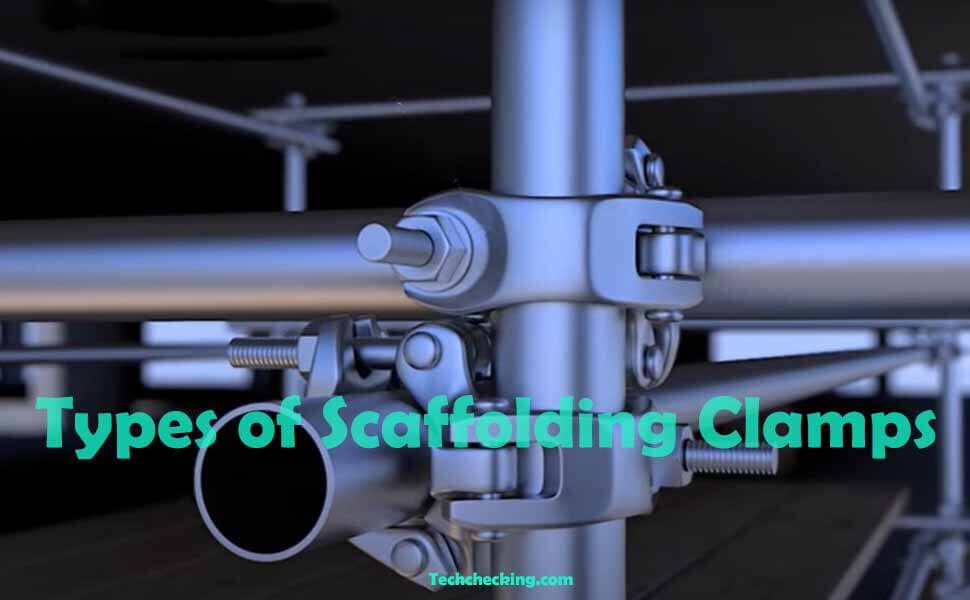Scaffolding clamps are essential especially when a temporary platform is used to elevate and support materials during the construction or repair of a structure or machine. Different sizes, lengths, and types of scaffolding clamps are required during this process. What kinds of scaffolding clamps are needed will depend on the methods of support and the structure. In this article, we are going to know different types of scaffolding clamps that can help you do your job smoothly. However, besides this topic, you can know more about different types of clamps for pipes as well. Enriching knowledge will make you smarter.
What Are Scaffolding Clamps?
Scaffolding clamps are kinds of metallic devices that are used to the joint between pipes in order to secure those pipes in place so that they don’t displace or slip away. Workers use scaffolding structures to climb up and down. Once scaffolding structures are made by scaffolding clamps, climbing up to higher levels safely and securely is really easy. This is why the scaffold is usually made from strong and high-grade metal such as steel. However, to create a strong and sturdy scaffold structure, steel pipes are to be affixed. A scaffolding clamp plays a vital role to create an angle or a straight line. In addition, the clamps tightly secure the components for use.
Scaffolding clamps are commonly used in most construction sites. The structure made by clamps is temporary and a safe work platform. Scaffolding clamps structures are made of steel tubes and clamps and this is why they are generally called tube and coupler scaffolds. We will talk about this too a bit later. If you are wondering where are these scaffolding clamps used, well, you can see them used commonly in construction job sites, maintenance, repair of a building, support material, bridges, and other man-made structures. Engineers and technicians play a great role in using the scaffolding clamps.
Types of Scaffolding Clamps
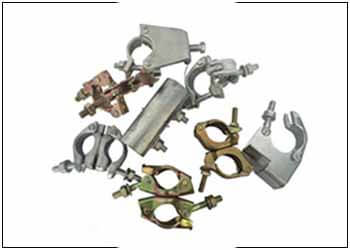
Due to increased productivity and safety, scaffolding clamps are being important as construction tools in today’s world. This mechanism doesn’t only make the task easier, it enhances the safety of the worker. Wondering how many types of scaffolding clamps or how many types of clamps are there? We know there are different types of scaffolding clamps. However, while we are discussing types of scaffolding clamps, there are three types of scaffolding clamps in accordance with the fundamental mechanical differences.
- Tube and coupler scaffolding
- H-frame / facade scaffolding
- Multi-directional scaffolding
Since we have got the types of scaffolding clamps, let’s discuss them. It would be an amazing journey to know all of them.
Tube and coupler scaffolding
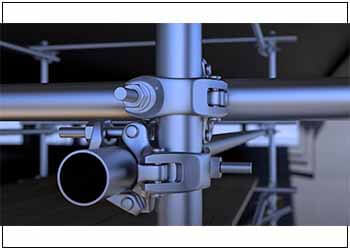
This is the most known, versatile, and oldest type so clamp. They consist of steel tubes and clamps. As mentioned earlier, these are temporary structures to help raise the building or repair. In a word, the main purpose of this tube and coupler scaffolding is to support the crew making sure they are safe while climbing up and down.
Structure
There are two main components to make the structure; the tube and the couplers. Here, the tube plays the key role of the scaffold while couplers are the tube joints. The horizontal and vertical steel tubes are jointed via right-angle clamps. The steel tubes are connected to stabilize the scaffold so that workers can work safely.
H-frame / facade scaffolding
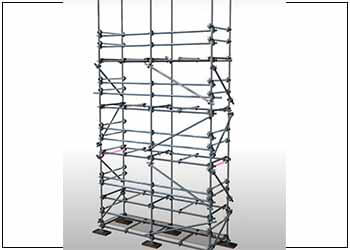
Now we will discuss H-frame or facade scaffolding. The H-Frame describes itself how it will be. It will be like a ladder that is used for stepping upward and downward. If you need to do painting, plastering, exterior covering, and so on your building, this structure is really fruitful. In a word, if you have anything to do with exterior types of work for your building, the H-frame scaffolding is the best. So, this is vastly used for all types of façade works. The H-frame / facade scaffolding is popular with all because the clamps are very easy to assemble and disassemble.
Structure
We will now know how the structure of the H-frame works. First of all, each system of the H-frame scaffold has modules. Every module consists of one horizontal and two diagonal members to build the frame. So, we need an H frame, a safety fence, and diagonals. The frame’s length is 42×2 mm and the diagonal measured 27×2. If you observe the image of the H-frame or façade scaffolding, you will notice that the pipe inserted in the H component is for the mounting purpose. Very simple to make the structure. This ladder-type scaffolding is used for carrying a different types of slabs.
Multi-directional scaffolding
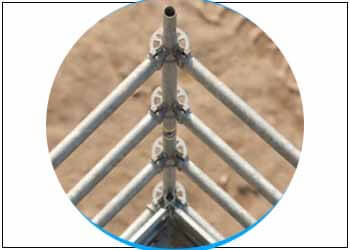
A multi-directional scaffolding is kind of a complex job. The scaffolding clamps are made up of 8 drill steel rods for additional sturdiness and strength. Though it is a more difficult job than the other two scaffolding, the multi-directional scaffolding brings maximum productivity. The high-quality steel ensures safety and strength to the frame. This type of scaffolding works best for multi-directional purposes. Placing the tubes at any angle can make multi-directional ways to work and this is how the work accelerates.
Structure
This type of scaffolding clamps is complex to build but brings the best result of all. Ledgers, diagonals, and transoms are joined together to be connected. They are with a hammer through a wedge coupling head too. Without a doubt, these are all made of high-quality stainless steel.
There is no way to put less importance on the different types of scaffolding clamps. In the job sites, they have their own importance and every type of scaffolding clamp plays its own role. These are made for the workers to get the job done easily and quickly. Despite the different types of clamps, every type has similar components to scaffolding.
So, do you know the elements and the components of a scaffold clamp? Well, if you don’t know yet, we will discuss the main components of scaffolding clamps here now.
Main components of scaffolding
Knowing the main components of scaffolding is important. If you are a professional, you must know these names. Let’s now introduce the main components of scaffolding.
Standards – these are vertical members of scaffolding clamps frame and are embedded in the ground.
Ledgers – this component works by being parallel to the wall. They are a kind of horizontal supporting of scaffolding clamps frame.
Putlogs – they are positioned at the end of the ledger of the scaffold.
Boarding – a component that is a horizontal platform supported on putlogs.
Toeboard – It gives protection to the working platform.
Transoms – these components are supported on both types of ledgers.
Braces – these are diagonally fixed on the clamps.
Guard rail – It is a ledger at the working level.
Bridle – this is a part of the clamp that is used for bridging the wall opening.
Importance of Scaffolding Clamps in Construction Company
The importance of scaffolding clamps is inexpressible. If you carefully observe you can see, any building under construction uses scaffolding. So this has become one of the most important tools for raising a building. We have already discussed its types and we already know its different applications in different sectors. In the USA, developers use these scaffolding clamps for repairing a building or for a new one. The scaffolding clamps are made of steel and they are strong enough to ensure the safety of the crew. Let’s now know the importance of scaffolding clamps.
Safety
Safety comes before everything especially when you are going to work on a high-rise building. Ensuring safety is a must. As we are discussing the importance of scaffolding clamps in a different construction company, the safety of the crew concerns first. However, the scaffolding clamps made of high-quality materials ensure safety and risk-free work. So, the different types of scaffolding clamps are great to make a safe working place.
Accessibility
Construction of a building may sometimes be difficult due to narrow space and hard-to-reach accessibility. In this case, scaffolding clamps are the tools that save your day. These tools let you easily access the tough places where going usually is not that easy. Setting up any type of scaffolding clamps can solve the problem and the employees can easily carry parts without any difficulty.
Less Time Consuming
Finishing a project before the timeline is an important agreement. In another way, time is the most important element for everyone. Well, using scaffolding clamps can get the job done pretty much quickly. Increased productivity and efficiency are the most features of them. You know Scaffolding is a rudimentary structure for construction companies. If anyone knows how to use scaffolding clamps properly, the job becomes so much easier and faster.
Efficiency
When the tools pave the way to do the job in an easier way, the work can be done in less time. Using scaffolding clamps are such tools that save time and energy. They are safe too.
Strategic Position
Scaffolding clamps can help plan the best strategic position for the construction job. It is the biggest advantage for the employees. And yes, due to the scaffolding clamps, they can be positioned in any direction according to your requirement and the work becomes easier. Know more.
Precautionary Measures
While you are using tools, some precautionary measures should be taken to avoid any unexpected occurrences. If you ignore these simple precautions before starting the job, there will be no guarantee to have proper safety for the crew. So, let’s see those precautionary measures.
Proper Training
Comprehensive understanding with training on the types of scaffolding clamps and their uses will make the workers more careful on the job. They will understand what to do and what don’ts. The depth of knowledge and teaching them the use of clamps can save lives.
Inspection
Another precautionary measure is proper inspection. There are many inspection teams in the USA and you can hire them if you are unable to do that. Regular inspection reduces the risk of accidents and it also keeps the working environment safe and secure.
How to calculate scaffolding load capacity
Calculating scaffolding load capacity is important to do the work smoothly without any problems. If you know better about it, you will be able to do the work perfectly. Let’s know something important from a table chart.
Scaffold Classes/ Duties and Dimensions
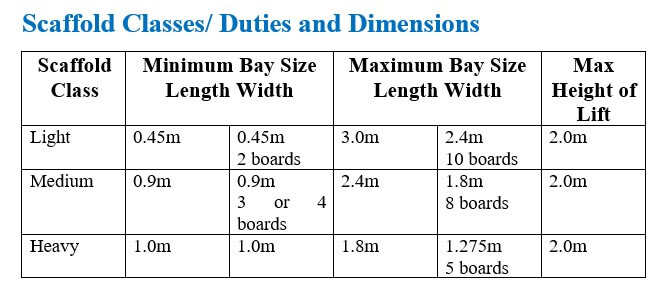
What are the types of scaffolding load?
There are some types of scaffolding loads mentioned here. Those are –
- Dead load
- Live load
- Static load
- Dynamic load
- Wind load
- Environmental load
How to calculate the DEAD load of scaffolding
Example of Dead load calculation of scaffolding
Scaffolding Pipe/tube weight 4.5 kg per meter as per BS EN 39:2001
1×3m standard = 14 kg.
1× Screw jack = 05 kg.
4× Ledgers 40 kg ÷ 2 = 20 kg.
4× Transoms =32 kg ÷ 2 = 16 kg.
1× Face brace = 18 kg ÷ 2 =9 kg.
1× End brace = 10 kg ÷ 2 = 5 kg
5× 2.4m planks = 100 kg ÷ 4 = 25 kg
TOTAL = 94 kg. (Dead load)
How to calculate Live load of scaffolding
| Light-duty Scaffold | Medium-duty Scaffold | Heavy-duty Scaffold |
| 225 kg/m2 | 450kg/m2 | 675 kg/m2 |
Live load = Workers weight + tools weight + materials weight.
SWL (safe workload of scaffolding) = D + (4 × L)
D= Dead load
L= Live load
Final Words
In this article, we have tried to cover almost every important aspect of different types of scaffolding clamps. If you have read the whole article, you may know some new information about it. Besides, you may have some questions in mind such as scaffolding clamp price, fixed clamp scaffolding, swivel clamp scaffolding, scaffolding clamp size, and so on. Well, we will try to cover them later as well. If you have anything to ask, you are welcome to reach out to us. Thank you.
You May Like –
- 12 Different Types of Clamps for Pipes
- How to Cut Wire Rope Cleanly [Step by Step Guide]
- 7 Best Wire Cutters for Electricians
- Different Types of Wire Cutters
- Socket Wrench vs Ratchet – Core Differences

